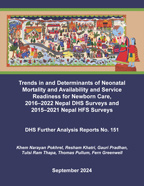There is no printed copy available to order.
Abstract:
For two decades, Nepal has made progress in
reducing the neonatal mortality rate (NMR).
However, the country has observed a stagnant
NMR of 21 neonatal deaths (reported per 1,000
live births) since 2016. Widened equity gaps
in NMR exist between socioeconomically
disadvantaged and privileged groups. Health
facility readiness and delivery of optimal
quality newborn care are fundamental for
improved health outcomes; however, limited
evidence is available on NMR trends and
determinants and the readiness of health
facilities to deliver newborn care.
Therefore, this study examined NMR trends and
determinants using data from the 2016 Nepal
Demographic and Health Survey (NDHS) and 2022
NDHS, as well as health facility readiness
for maternal and newborn health (MNH) care
using data from the 2015 Nepal Health
Facility Survey (NHFS) and the 2021 NHFS.
The study included 106 neonatal deaths (out
of 5,087 live births) from the NDHS and 105
neonatal deaths (out of 5,192 live births)
from the 2022 NDHS. Independent variables
included household-level background
characteristics and characteristics related
to pregnancy, MNH, women’s empowerment, and
health systems. The NMRs for 2016 and 2022
were constructed based on all births in the 5
years preceding the survey. General linear
modeling was used to assess significant
changes in NMR from 2016 to 2022 by
background variables. NMR determinants were
identified by conducting logit regression
analyses. Further, the World Health
Organization’s (WHO’s) service availability
and readiness assessment framework was used
to examine changes over time in health
facility readiness for MNH care based on data
from the 2015 and 2021 NHSF surveys.
Despite the stagnant NMR since 2016 at the
national level in Nepal, an increase in NMR
was found across socioeconomically
disadvantaged groups and mothers who did not
use MNH services. NMR equity gaps widened
among advantaged and disadvantaged groups
stratified by wealth status, education, and
ethnicity. Higher NMRs were observed among
newborns if they were from the poorest
households, their mothers had no education,
and they were from disadvantaged ethnicities,
when compared with privileged counterparts.
In contrast, NMRs were lower among mothers
with higher empowerment status and those who
utilized maternal services for their last
births, such as deliveries assisted by
skilled birth attendants and postnatal
checkups for newborns. Despite slight
improvements in health facility readiness for
delivery and newborn care between 2015 and
2021 at the national level, no improvements
were seen in health facilities in Madhesh and
Lumbini provinces or in the Terai ecoregion.
Health system efforts should include the
design and implementation of targeted
interventions for disadvantaged groups and
improve access to and delivery of MNH care.
Peripheral health facilities need to be
equipped with essential supplies and ensure
that trained health workers are available for
essential newborn care. Moreover, the
findings call for the expansion of neonatal
intensive care units and special newborn care
units at higher-level health facilities. A
specific survey focusing on neonatal
mortality and causes of death is recommended
to further examine the determinants after
adjusting for covariables and possibly
linking with health service readiness.
 Trends in and Determinants of Neonatal Mortality and Availability and Service Readiness for Newborn Care, 2016–2022 Nepal DHS Surveys and 2015–2021 Nepal HFS Surveys (PDF, 4075K)
Trends in and Determinants of Neonatal Mortality and Availability and Service Readiness for Newborn Care, 2016–2022 Nepal DHS Surveys and 2015–2021 Nepal HFS Surveys (PDF, 4075K)
